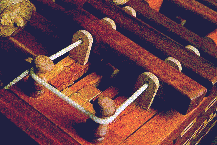

Check out my Marimba Links/Bookmarks/Favorites!
Disclaimer: This page is for beginning Marimba players. I do not pretend to be an expert on the Marimba nor a teacher. I am a rank beginner on the instrument, albeit with an extensive background in music.
As a rank beginner surfing the internet I have found a distinct lack of material for those who are brand new to the instrument. Most of the sites I have encountered thus far assume that the reader already knows quite a bit. The purpose of this page is to pass on to others what I have learned as a beginner and to fill the gap.
If your browser can display images, the one at the top of the page is an example of a concert grand marimba of the type you would find in an orchestra. It is also very similar to the marimba that I now own. For a larger view of the instrument, just click here.
The marimba is officially a member of the xylophone family with full length resonators below each bar. On top-of-the-line instruments the resonators are made of aluminum or some other metal and are carefully tuned to bring out the fundamental note of each bar. On more primitive instruments the resonators may be simply hollowed-out gourds, as can be seen in the picture below:

The bars are usually made of rosewood or a newer synthetic material, such as Ludwig-Musser's "Kelon". Rosewood is preferred but is, unfortunately, very expensive. The bars are supported at their nodal points by cords that run along the axis of the instrument, and the cords in turn are supported on wood or metal "fingers" that stick up from the top of the instrument, as can be seen in this photo:

On modern instruments the bars or "keys" are arranged much as they are on a piano: the bars for the sharps and flats (corresponding to the black piano keys) are in a second row further from the player and slightly above the row of bars representing the natural notes (the white keys on a piano. This is easily seen in this close up of a concert grand marimba. (The instrument in the photo is shown from the audience's point of view. The player would stand on the other side of the instrument.)
The marimba is played by striking the bars with mallets which come in a wide variety of shapes, coverings, weights, and sizes. Each imparts the instrument with a different timbre, (as does of course the player's technique!) Some mallet heads are simply made of rubber or other synthetics graduated in hardness from soft to hard. Other mallet heads consist of a core covered with yarn, cord, or rubber. By controlling the core and winding a large variety of timbres are possible. Handles are usually made of birch, rattan, or fiberglass:

Because the marimba is played with mallets and is often arranged as a keyboard, it is often referred to as a "mallet percussion" or "keyboard percussion" instrument.
Marimbas are, unfortunately, very expensive. A good marimba will typically cost you as much as a decent piano. List prices for marimbas start at around $2500 and go all the way up to $15000 and higher. The "street price" (the price one would actually pay) is usually quite a bit less if you can find a dealer that offers a good discount. If you can find a used one, so much the better. Like most fine musical instruments, a marimba will not wear out. A used one is as good as a new one if it has been taken care of.
First, the bars on the better instruments are usually made of rosewood which has gotten very expensive. Second, despite their apparent simplicity, a lot of work goes into the making of each bar. Each bar is specially cut on the underside to tune both the second and fourth harmonics to the fundamental (a technique called triple tuning.) This must be done by hand for each indiviual bar. This results in a much more pleasing tone, but adds to the cost. Third, the resonators are also expensive, and on the better instruments each is individually tuned by hand, rather than simply being preset to some pre-determined location. The result: better sound but higher cost. Now multiply the cost of each bar and resonator by 36 to 54 (since most marimbas have from 36 to 54 bars) and add on the cost of the frame and it's easy to see why they cost so much!
While searching the internet for information I have come up with a variety of links that may be of use. Included are links to performers, retailers, manufacturers, accessories, sheet music, recordings, general marimba information, and so on. If you know of a link that I should include please E-Mail me at glatta@frostburg.edu and I will be happy to add it to the list.
Picture Credits:
The pictures of the Musser Concert Grand Marimba and mallet heads are courtesy
of the Ludwig-Musser
Company.
The pictures of the primative marimba, bar support, and original background are
courtesy of theVirtual Museum of
the Mexican Marimba.
The mallet picture is courtesy of Mike Balter
Mallets.
Please visit these sites and give them your support.
Back to Dr. Greg Latta's Educational Web Pages
 If you have any questions or
comments, you can send E-Mail to Greg at
glatta@frostburg.edu
If you have any questions or
comments, you can send E-Mail to Greg at
glatta@frostburg.edu